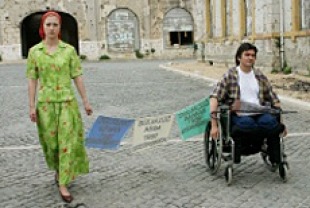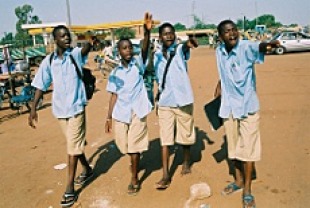Read an interview with Iranian director Samira Makhmalbaf about the global impact of images.
Three thousand people were killed when the World Trade Center was attacked by terrorists. To read aloud a list of their names takes over two hours — about the same time it takes to watch this poignant collection of movies gathered together by French producer Alain Brigand. He wrote eleven world-class directors and gave them this assignment: "Create a film lasting eleven minutes, nine seconds and one frame — SEPTEMBER 11 — around the events of September 11 and their consequences." The result is a rounded and eclectic smorgasbord of images and imaginative approaches to the event that stunned America and shocked the world.
The touching and innovative film by 21 year-old Samira Makhmalbaf (The Apple, Blackboards) of Iran is the best of the lot. An Afghan teacher who has learned of the World Trade Center tragedy finds her young students working frantically with other members of their immigrant community in Iran to build mud shelters to protect them from an American attack. She tells them that bricks won’t keep them safe from bombs, but no one is listening. The fear is palpable on the faces of the adults.
After finally bringing all the kids together, she asks them if they know what has happened overseas. They don’t know but everyone in the room has heard about two men who fell in a local well and one died. When the teacher asks them to observe a minute of silence as a sign of respect for the victims at the World Trade Center, the children squirm restlessly. Two talkative children share their ideas about God and killing. The frustrated teacher takes the class outside to stand in front of a smoking brick kiln that looks like a tower. The silence takes hold and for a brief shining moment, thanks to the teacher’s empathy and persistence, everyone is linked to those who have lost loved ones in the terrorist attack on the other side of the world.
Two other very powerful cinematic creations make an explicit connection between the terrorist attacks in America and other events which took place on that same day in other countries in other years. English filmmaker Ken Loach (Sweet Sixteen, Bread and Roses, Carla's Song, My Name Is Joe) focuses on exiled Chilean singer Vladimir Vega, who is writing a letter of sympathy and solidarity to relatives who lost loved ones in the Twin Towers. His current activities are juxtaposed to archival footage of another infamous day — September 11, 1973 — when the Socialist government of Salvador Allende was overthrown by a murderous coup arranged by the U.S. Secretary of State Henry Kissinger and the CIA. The new installed regime of Augusto Pinochet turned out to be brutal and merciless in their attack on anyone connected with Allende; more than 30,000 people were killed. Out of all the films made for this ambitious project, Loach's is the most forceful in its attempt to answer the question: Why was the United States attacked and what could the American government have done in the past to bring about such a violent response from its enemies?
In the same spirit but with less visceral impact is the movie by Danis Tanovic (No Man’s Land), a Bosnian filmmaker who zeroes in on a demonstration by widows in honor of those who lost their lives in the 1995 Srebrenica massacre. A young woman who has just spent another sleepless night decides to march for what she believes in despite the fact that the terrorist attacks on the World Trade Center and the Pentagon loom large in the consciousness of everyone around her. When she joins the march, she finds that other women feel the same way she does.
This refusal to allow local concerns to be overshadowed by what took place in New York City shows up in four other films. Idrissa Ouedrago centers his story around five poverty stricken young boys in his home country, West Africa’s Burkina Faso. One of their number is deeply saddened by the illness of his mother, who is not able to afford medicine or his school supplies. Then he spies a bearded man in town who looks like Osama bin Laden. With great energy, he contacts his closest friends and tells them that if they capture this terrorist, they will receive the $25 million reward. Their adventures together briefly lift their hopes up for a better future. One person’s poison, we see, can be another’s source of liberation.
Israeli director Amos Gitai uses his eleven minutes to focus on a car bombing in Tel Aviv where soldiers, rescue workers, and journalists are all thrown together in a net of anger, chaos, and loss. A reporter who is trying to cover the incident is outraged by the idea that her story will be scrapped for the bigger story of the terrorist attack in America.
Films by French director Claude Lelouch (Les Miserables), American director Sean Penn (The Crossing Guard, The Pledge), and Indian director Mira Nair (Kama Sutra, Mississippi Masala, Monsoon Wedding take place in New York City. The first revolves around the impending breakup of a deaf mute and her boyfriend, a tour guide. While she is writing a farewell letter to him, he is caught up in the chaos near the World Trade Center.
Sean Penn zeroes in on the grief of an elderly man (Ernest Borgnine) who has lost all touch with the reality of the outside world since the death of his beloved wife. In a moment of genuine magic, light streams into his dark apartment when the Twin Towers collapse. The dried flowers in a bouquet instantly become blooming beauties. Death and transformation go hand in hand in this world.
The true story recounted in Mira Nair's film is about a New York Pakistani mother who finds out that her missing son has been labeled a terrorist by law officials. This news cuts her to the quick and leaves her in a state of deep shock. It is only months later that the true account of his whereabouts is discovered. In a very graphic way, Nair shows how the anger and revenge afoot in the city after 9/11 did nothing but worsen the situation by extending the circle of pain.
Only three of the eleven miss the mark. Egyptian Youssef Chahine tries to do too much with his depiction of a filmmaker who meets a slain American soldier in his dreams and then spends some time with a Palestinian terrorist. Mexican director Alejandro Gonzalez Inarritu’s (Amores Perros) non-narrative film contains inappropriate images of victims who leaped from the Towers' upper floors and fell to their deaths. And Japanese director Shohei Imamura (The Eel) tries to make the point that "there is no such thing as a holy war" in a convoluted tale about a World War II soldier from Japan who sees himself as a snake.







